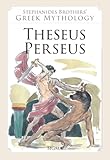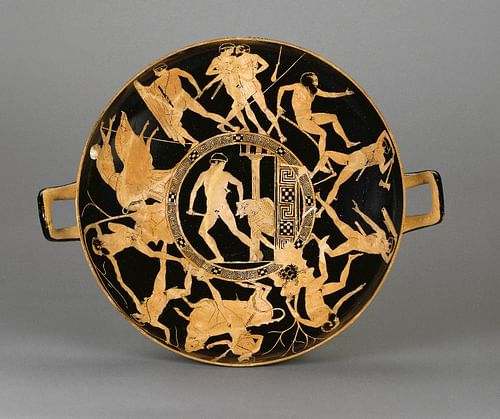
Theseus is a legendary hero from Greek mythology who was considered an early king of Athens. Famously killing villains, Amazons, and centaurs, Theseus' most celebrated adventure was his slaying of the fearsome Minotaur in the labyrinth of the Cretan king Minos.
In the Classical period, Theseus came to represent the perfect Athenian - the just man of action determined to serve his city as best he could and the staunch defender of democracy. Theseus appears in several Greek tragedy plays and his battle with the Minotaur was a favourite subject of Greek vase painters. He is the subject, too, of one of Plutarch's Lives biographies.
Early Adventures of Theseus – the Labours
In legend, Theseus' father was considered either the son of the god Poseidon or King Aegeus of Athens. His mother was Aethra, daughter of Pittheus, the king of Troezen, whom Aegeus seduced. Theseus spent his childhood at Troezen in the northeast of the Peloponnese as Aegeus had warned Aethra not to tell her son who his real father was until he came of age, perhaps explaining why Theseus was considered the son of Poseidon in his youth. When a young adult, the hero gathered up gifts of sandals and a sword from his father which had been buried under a heavy rock for when he was old enough to lift it. With these tokens, Theseus set off for Athens to claim, as Aegeus' only son, his inheritance, the kingdom of Athens. Before he could reach the city, though, he first had to battle various villains and monsters.
The first villain to be dispatched was Periphetes, who smashed the heads of anyone he came across with a huge iron club. Theseus killed him without ceremony and took his club as a handy weapon for his future adventures. A similar baddy was Sinis (also Sines) who hung around the Corinth countryside and bent pine trees so that they might strike and kill people who passed through the Isthmus. Our hero killed the troublesome Sinis using, of course, a bent pine tree. According to Plutarch, Theseus had a son, Melanippus, by Sinis' daughter Perigune.
Next came Skiron who blocked the narrow sea passage through the rocks of Megara. He took delight in forcing people to wash his feet and when they bent down to do so he would kick them over the cliff and into the sea. Whether the unfortunate travellers survived the fall or not was irrelevant as, in any case, they were then eaten by a giant turtle that haunted those parts. All this frightful behavior was put to an end by Theseus who kicked Skiron into the sea to be eaten by his own accomplice or, in another version, to be turned into a rock.
Next in line came Kerkyon, the champion wrestler who crushed to death anyone who passed his way, but Theseus beat him at his own sport. The last scoundrel was Prokroustes (also Procrustes or Damastes) who waylaid travellers and forced them onto a bed; if they were too tall for the bed he would chop off the excess, if they were too short he would stretch them using weights or hammer their limbs to increase their length. Theseus swiftly dealt with him too by putting him on his own device.
Finished with littering the Greek countryside with dead villains, Theseus then had to kill a bad-tempered sow called Phaia which was causing trouble, again, in the Corinth area. He finally did arrive at Athens, where he was not helped by his jealous step-mother Medea. She and Theseus' cousins, the Pallantidae, tried several times to do away with our hero but their ambushes and poisonings came to nothing. Medea then sent Theseus off on the dangerous errand of dealing with the bull of Marathon which was terrorizing the countryside. The hero captured the animal and sacrificed it to Apollo. In yet more adventures, Theseus even found time to help Meleager in the Calydonian Boar hunt and to accompany Jason and his Argonauts on their quest to find the Golden Fleece, but his greatest trial was yet to come.
Theseus & the Minotaur
Theseus' most famous adventure was his slaying of the Minotaur of King Minos on Crete. Every year (or every nine, according to Plutarch) Athens was compelled to send seven young men and seven young women to feed this fearsome creature with a man's body and the head of a bull, which dwelt in the mysterious labyrinth at Knossos, built by the famed architect Daedalus. The terrible tribute was, in some sources, compensation for the death of Minos' son Androgeous, killed by jealous competitors after he won at the Athenian Games (in other versions he was killed by the bull of Marathon). The unique Minotaur came from the union of Minos' wife Pasiphae and a bull after the queen was made to fall in love with the animal by Zeus as revenge for Minos' refusal to sacrifice it in the god's honour.
Theseus, seeking to put a stop to this barbarity, enrolled himself as one of the seven youths and sailed to Crete. On the way, our hero, with the help of Amphitrite, Poseidon's wife, retrieved a ring which had been thrown into the sea by Minos. On arrival Theseus fearlessly entered the lair of the Minotaur from which no one had ever come out alive. There, with the help of Ariadne, daughter of Minos, the hero marked his way through the winding passages of the labyrinth using a ball of string. Striking down the beast with his sword, he easily followed the string back to the labyrinth's entrance and freed Athens from her terrible obligation to Minos.
Sailing back to Athens, Theseus rather ungallantly abandoned Ariadne on the island of Naxos, perhaps on the advice of Athena, but she soon found solace in the arms of the god of wine Dionysos, whom she married. In another version she is killed by Artemis, acting on instructions from Dionysos, who had once been betrothed to the princess and was miffed to have lost her to Theseus. The hero then stopped at Delos, offered a sacrifice to Apollo, and performed what would become a famous dance, the geranos or Crane dance, which mimics the movements inside the labyrinth.
Theseus then sailed on home but was hit by tragedy when he forgot, as he had promised to his father before setting off, to hoist a white sail instead of the usual black one (set as a mark of mourning for the doomed youths) which would signal to his waiting father that all was well. Theseus' father saw the black sail, thought his son had been killed by the Minotaur and, utterly distraught, threw himself off the cliff into the sea below. Thereafter, the sea carried his name, the Aegean. Theseus thus inherited the throne and he settled down to government, unifying the many small settlements of the area into a single political unit (synoecism), and establishing a peaceful and prosperous period for Athens.
Battling Amazons, Centaurs & Hades
This was not the end of Theseus' adventures as he was involved in several other myths too. He fought the Amazons alongside Hercules when they invaded Attica to regain the girdle of their queen Hippolyta, aka Antiope, which Hercules had stolen as one of his labours. In some accounts, Hippolyta was Theseus' first wife and together they had a son, Hippolytos. Next up, Theseus fought the centaurs, the half-man, half-horse creatures, which had disrupted the wedding of Theseus' good friend Pirithous (Peirithoos) of the Lapiths.
Theseus then tried to abduct Persephone from Hades in the underworld so that Peirithous might marry her. Hades was not to give up his bride so easily (especially after the trouble taken to get her down there in the first place) and he tricked the pair into sitting on thrones which entrapped them. Theseus was only rescued by the exploits of Hercules, who had come to capture Cerberos in his final labour, but Peirithous was, alas, left to his fate.
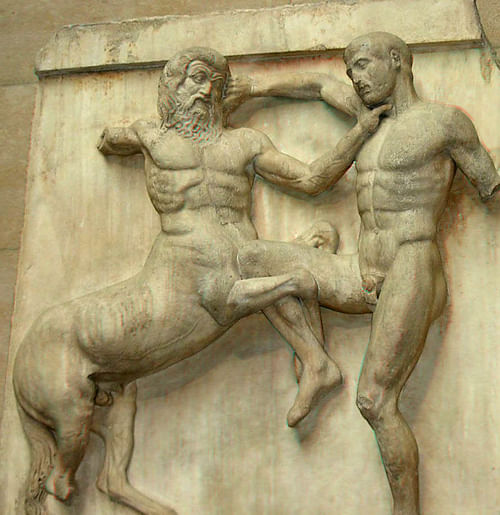
Theseus' second wife was Phaidra, sister of Ariadne, with whom he had two sons, Akamas and Demophon. Unfortunately for family harmony, Phaidra then fell in love with her step-son Hippolytos. Her advances were not reciprocated, though, and scorned, she furiously told Theseus that his son had tried to rape her. Outraged, Theseus called upon Poseidon to punish Hippolytos, and the god of the sea responded by sending a bull from the depths of the ocean. This creature so frightened the horses of Hippolytos' chariot that they tipped the youth into the sea where he drowned. Phaidra, hit by pangs of guilt, then hanged herself to complete a typical cycle of Greek tragedy.
In another abduction, but this time more successful, Theseus captured Helen when she was a child and gave her to his mother to look after until she reached womanhood. The girl was rescued by her brothers, though, the Dioscuri. The latter invaded Attica for the purpose and Theseus was forced to flee to the Aegean island of Skyros. According to legend, the hero was killed there by King Lycomdedes, who pushed him off a cliff. His bones were eventually recovered by the Athenian statesman and admiral Cimon c. 475 BCE, who brought them back to Athens and placed them in a temple, the Theseion. Theseus was subsequently honoured by the Theseia festival held each year in the city and was forever associated with the 8th day of each month, the traditional day the hero had first arrived in Athens as a youth.
What is the Significance of the Theseus Myths?
The myths involving Theseus became prominent in the 6th century BCE, at a time when the city of Athens was entering a period of dominance in wider Greece. Theseus may have been a convenient alternative to that other great Greek hero Hercules, and he gave the city a prestigious heritage which differed from other cities. Theseus was also promoted by the Athenian statesman Cleisthenes, who was arch-rival to the Peisistratids who regarded Hercules as the symbol of Athens' strength. The long list of villains that Theseus deals with is also very similar in nature to the older story of Hercules' twelve labours. In his fight against the Amazons and centaurs, Theseus was likely a metaphor for Athens' resistance against foreign attack.
The requirement of paying a tribute of youths to Minoan Crete may have been based on a real payment of tribute to the Aegean's dominant trading power in the middle Bronze Age. The Minoans were also bull-worshippers as attested by archaeological finds such as bull horn architectural decorations, bull rhytons, and frescoes, and other artwork depicting a sport of bull-leaping. In addition, the palace of Knossos was extremely large for its time and was composed of multiple small adjoining rooms, many with columns and open ceilings acting as light-wells. It would not be at all surprising that Athenian visitors might consider this architectural wonder a labyrinth. In another possible link, the very word labyrinth may be connected to the labrys, a double axe symbol of important religious significance to the Minoans.
How is Theseus Represented Art & Literature?
Theseus appears, in particular fighting the Minotaur, in Greek art from the last decade of the 6th century BCE. Scenes from the hero's battles on his first journey to Athens were present in relief sculpture on the Hephaesteion of Athens and the Athenian treasury at Delphi - both buildings date to c. 500 BCE - and the temple of Poseidon at Sounion and the heroon at Trysa in Lycia.
The hero's battles with the bull of Marathon and the Minotaur were particularly popular with black-figure vase painters, the finest example being the Francois Vase, which shows many scenes from the Theseus story. Special mention should be given to a magnificent Attic red-figure Kylix, now in the British Museum, which depicts all of the hero's labours. Theseus is distinguished from similar painted scenes of Hercules fighting a bull and centaurs as the former is usually depicted without a beard.
Theseus appears in the tragedies of both Euripides (Hippolytus and Suppliant Women – where he criticizes tyranny and defends democracy) and Sophocles (Oedipus at Colonus). Finally, the labyrinth appeared on Cretan coins, and the motif was also a popular device in Roman art, especially floor mosaics.
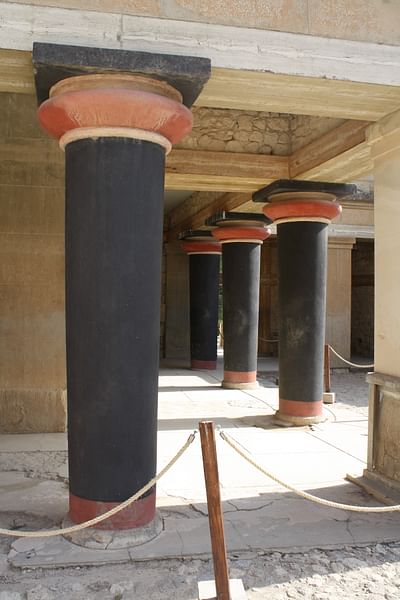
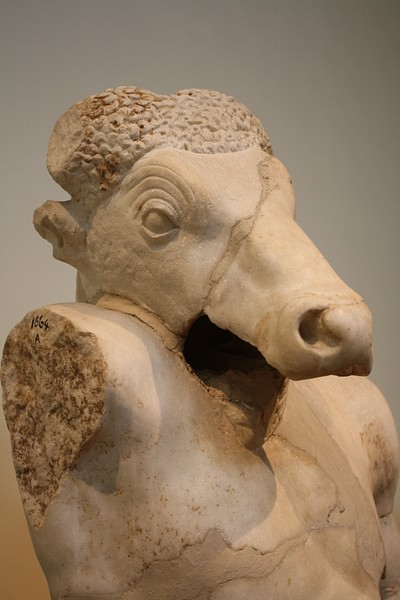
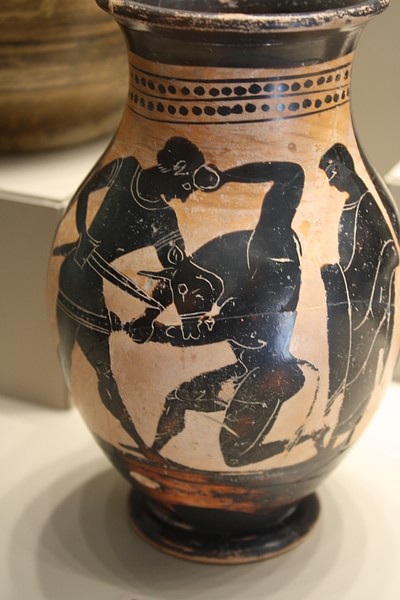
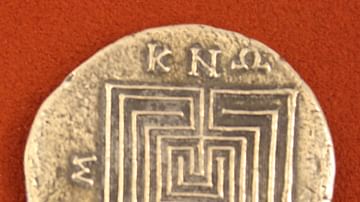







![Theseus: Battling the Minotaur [A Greek Myth] (Graphic Myths and Legends)](https://m.media-amazon.com/images/I/51dKK0z5JTL._SL160_.jpg)

